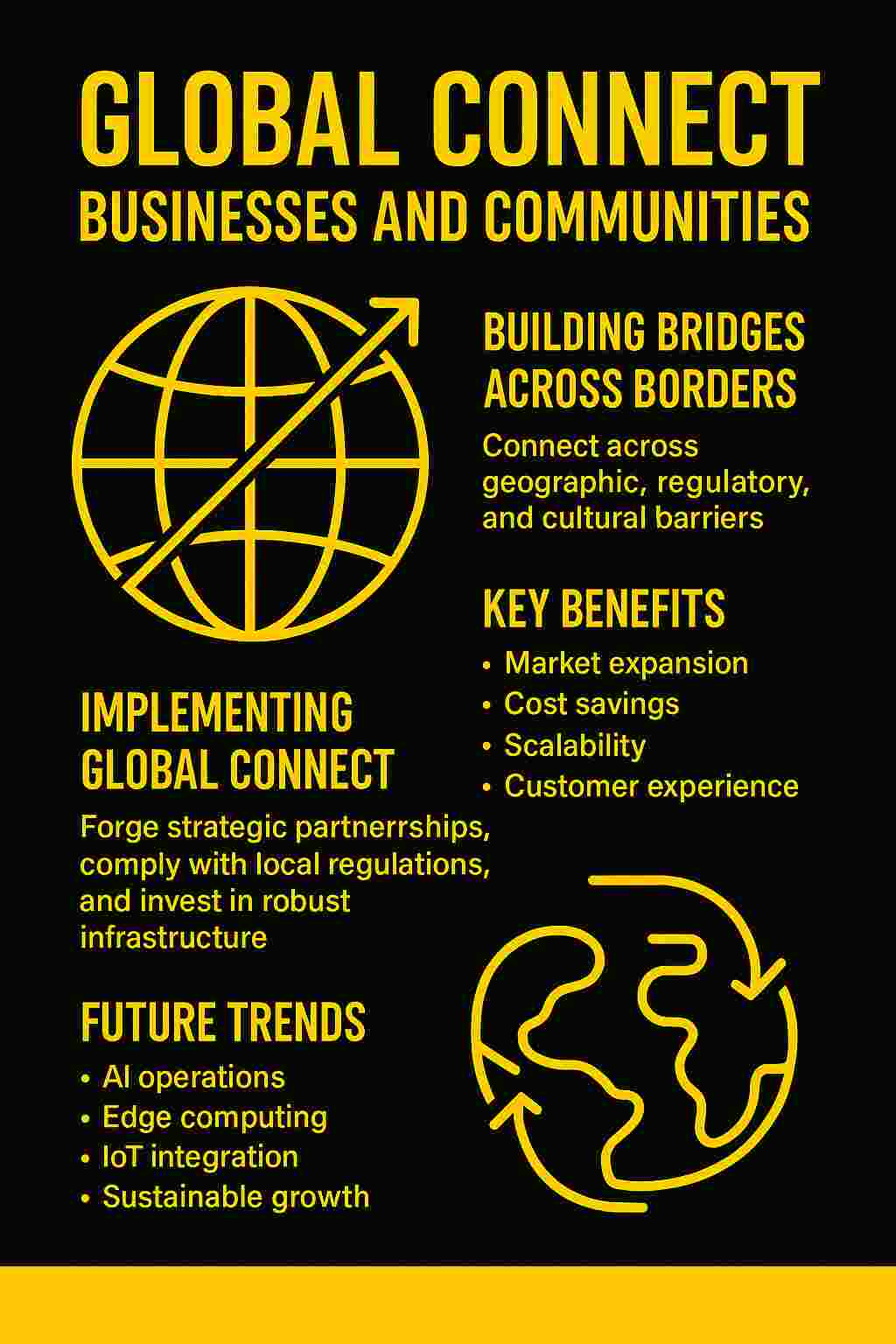In today’s hyper-connected world, global connect isn’t just a concept—it’s a strategic imperative. Whether you’re a publisher expanding into new markets, a telco scaling infrastructure across regions, or a startup launching global services, building reliable, efficient, and scalable cross-border connections is key. This guide explores global connect: why it matters, how it works in different industries, best practices, challenges, and what the future holds. By the end, you’ll understand how to leverage global connectivity to transform your organization.
Understanding Global Connect in the Modern Era
What Is “Global Connect”?
At its core, global connect refers to systems or services that enable seamless international linkages—through logistics, telecom infrastructure, supply chains, or digital platforms.
Why We Need Global Connect
-
Breaking boundaries: it helps businesses overcome geographical, regulatory, and logistical barriers.
-
Efficiency and speed: localized services reduce costs and improve performance.
-
Customer reach: brands gain access to new markets, while customers get faster, tailored service.
Key Benefits of Global Connect
Infrastructure Efficiency and Cost Savings
GlobalConnect’s upgrade to 400 Gbps optical capacity using Nokia tech has created a robust, low-latency fiber backbone across Northern Europe
MTN’s 100,000 km exclusive African fiber network reduces dependency on multiple vendors MTN.com.
Scalability and Flexibility
After merging with TCN, Global Connect moved its contact-center and telecom services into a flexible, scalable cloud model
Improved Customer Experience
AI-powered monitoring at GlobalConnect detects and resolves network issues before users notice, drastically reducing downtime and elevating service transparency
In publishing, local printing leads to faster delivery, fewer returns, and stronger relationships with regional bookstores
Core Models of Global Connect
Print-on-Demand & Distribution Global Connect
IngramSpark’s model powers truly global distribution by printing 11+ languages locally—saving costs and increasing availability
Telecommunications Backbone Global Connect
MTN GlobalConnect provides fiber, submarine cables, IP/MPLS, and roaming via a unified SLA, creating seamless access across Africa and beyond
GlobalConnect A/S runs an interconnected Nordic backbone (Norway, Sweden, Finland, Denmark, Germany, Netherlands) via 400 Gbps links .
Data Platforms & Cloud Services
Global Connect integrated its telecom and contact-center operations after merging with TCN, establishing a powerful cloud-based solution
AI-driven monitoring across hundreds of thousands of kilometers of infrastructure empowers proactive support
Implementing Global Connect: Best Practices
Stakeholder Alignment & Partnerships
Local partners (printers, telco providers) must be carefully vetted. IngramSpark does this to guarantee quality and regulatory compliance .
Telco deployments require technical, legal, and operational alignment before global launch.
Regulatory and Compliance Frameworks
Different regions have unique import, data, telecom, and local compliance laws. Central coordination is essential—Telefónica’s roaming hub illustrates how a unified model simplifies this Globema EN.
Tech Infrastructure & Security
GlobalConnect A/S fused legacy OSS platforms using GE Smallworld in a large-scale data migration—integrating thousands of devices and conduits
AI platforms (e.g., ScienceLogic) reduce monitoring complexity and bolster security
Operational Readiness & Support
Unified dashboards and AI monitoring provide mission-critical assurance and faster issue resolution
Local training and quality control ensure partners meet global standards—particularly important in printing and telecom.
Challenges & How to Overcome Them
Cultural and Market Differences
Products must be localized—IngramSpark’s authors translating metadata and adjusting pricing for each region’s market Ingram Content Group+8IngramSpark+8SelfPublishing+8.
Regulatory Complexity
Cross-border telecom involves navigating data privacy, tariffs, and licensing. A centralized compliance approach is vital.
Technical Integration & Data Silos
Integrating ops from multiple acquisitions creates silos. GlobalConnect’s Smallworld-first consolidation resolved this Globema EN.
Investment and ROI
Initial costs for fibre, cloud services, and print-on-demand are high—but ROI shows through expanded reach, reduced inventory, and better support.
Future Trends in Global Connect
AI-Empowered Operations & Predictive Maintenance
ScienceLogic integration creates visual workflows and resolves issues before impact .
Edge Computing & Localized Delivery
Distributed computing at print or telecom points-of-presence delivers faster service with lower latency.
IoT and Multi-Device Integration
Telefónica’s single IMSI roaming hub serves MVNOs and IoT devices around the globe .
Sustainability & Regional Growth
MTN’s 100,000 km fiber infrastructure across Africa supports sustainable regional development Capacity Media+2MTN.com+2Globema EN+2.
IngramSpark’s POD model cuts emissions by eliminating unnecessary printing and shipping Ingram Content Group.
FAQ – global connect
-
What is global connect?
A system or service enabling reliable international connectivity—from printing and shipping to telecom infrastructure and cloud services. -
How does global connect improve market access?
It eliminates shipping costs, reduces latency, and meets local preferences—making global expansion easier and more affordable. -
Which industries benefit most?
Publishing (print-on-demand), telecommunications, cloud-based contact centers, IoT providers, and any business with global customers stand to gain. -
What are the main challenges?
Expect cultural adaptation, regulatory complexity, technical integration, upfront costs, and stakeholder coordination. -
How can small businesses start implementing global connect?
Begin by identifying local partners, assess regulatory requirements, pilot with one region, and scale through strategic partnerships. -
What future trends should companies watch?
AI-powered monitoring, edge computing, sustainable infrastructure, IoT expansion, and responsible global networking.
global connect is no longer optional—it’s necessary for any organization looking to thrive in today’s global marketplace. By leveraging localized printing, interconnected telecom backbones, cloud platforms, and AI-powered monitoring, companies are building bridges across borders faster and smarter. The future favors those embracing AI, edge computing, and sustainability.
Takeaway: Assess your global readiness, invest strategically in partnerships and infrastructure, and pilot initiatives to scale globally with confidence. With a well-planned global connect strategy, your business can truly operate without borders.

